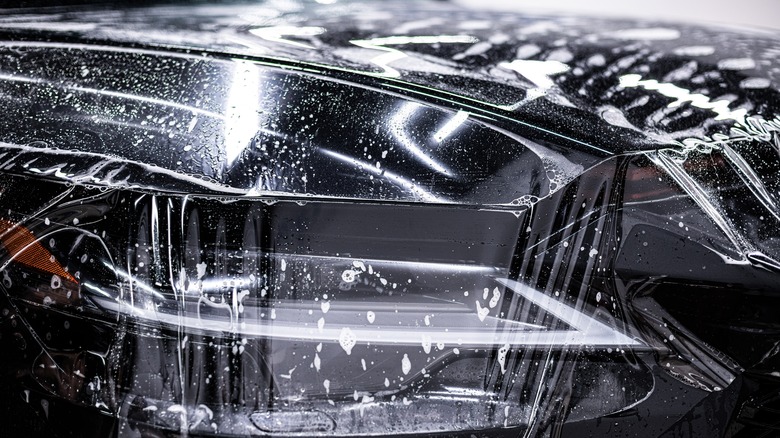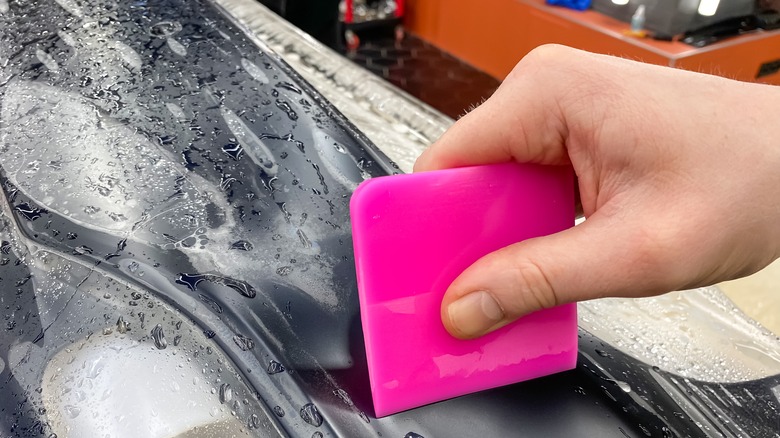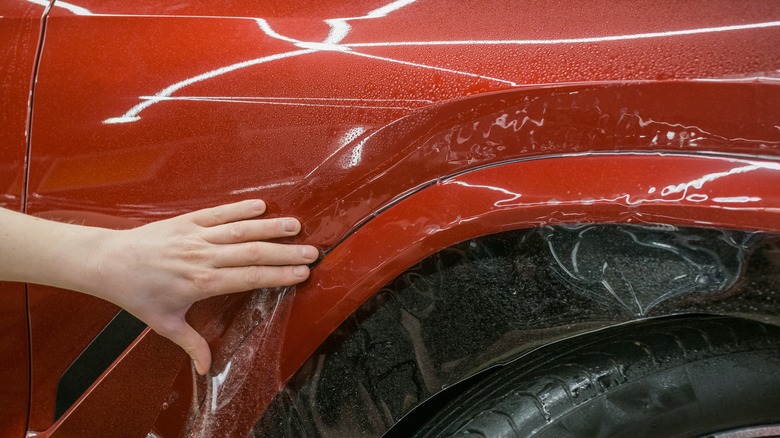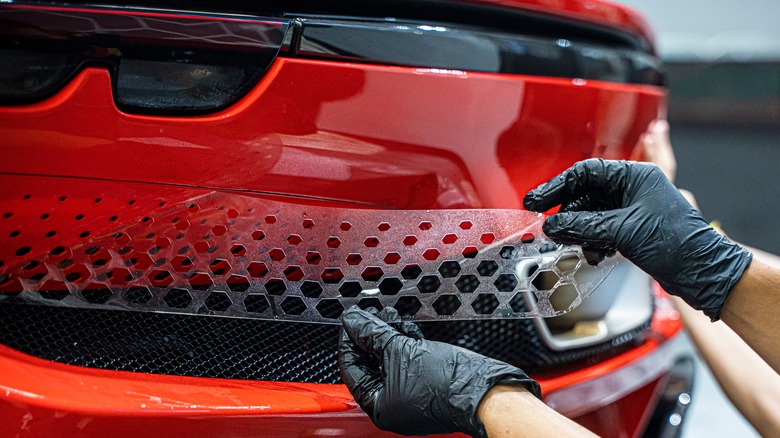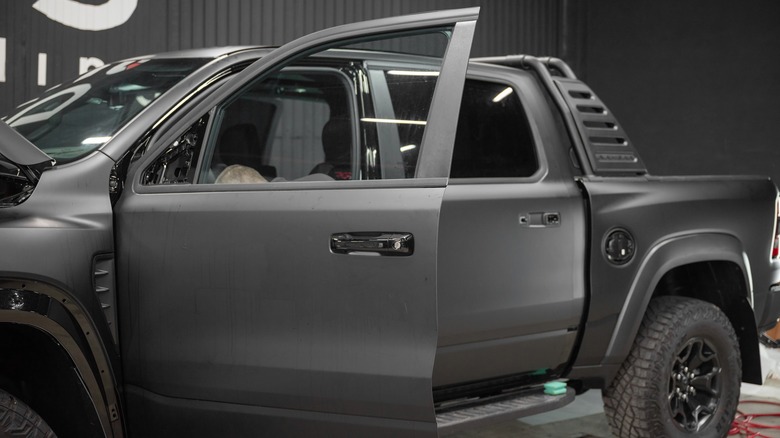What To Look For When Buying PPF For Your Car
So, you just bought a new car, and you can't wait to take it on a life-changing trip through some wide open roads. But before you leave the dealership, a siren says, "Wouldn't it be nice if your car would remain this beautiful forever?" Well, it could ... if you invest in Paint Protection Film (PPF).
For those into nail care, PPF or a clear bra is the equivalent of top coat nail polish to seal the fragile color of your car underneath. It's not required, and you can proceed off the lot without it, but you do run the risk of needing repairs.
At SlashGear, we've talked about PPF before and if it's actually worth the money. There are many factors that can affect if getting PPF is right for you, like where you live, the cost of your car, and if you're planning to sell it in the future. After all, it's not exactly cheap with an average cost of $4,500, according to the Maryland Autospa. Not to mention, you're likely going to need to budget for more, especially if you're driving a big car or have a lot of custom requests from your installer.
But, if you've already decided that's a must-have, here's a quick guide for what to look for when making your PPF purchase.
What are the types of PPF?
While there are hundreds of PPF options available on the market, most of them can be segmented into four key categories: Gloss, Matte, Colored, and Textured. That said, they all essentially do the same thing but vary in terms of aesthetics.
When choosing a PPF, another thing you should consider is the amount of protection you want for your vehicle. Apart from the preventive protection of PPF, which keeps the minor impact from things like rocks from damaging the actual paint, it can offer some degree of protection from minor dents, scratches from the elements, and bad parking blips. However, PPF can't prevent dents from major accidents. In some cases, some PPF options will also have self-healing properties, which works after being exposed to heat.
If you're still deciding, there are other options for protecting your car's paint job, like ceramic coating or vinyl wrap. In the past, we've covered all the differences between the clear bra and full car wrap. But if you need a refresh, the full car wraps don't just offer protection but double as a cheaper paint job. Vinyl car wraps are more for more cosmetic changes, which is great for people who can't commit to a car color long term. That said, ClearPro states that PPF is still the most durable option, lasting twice as long as both the ceramic coating and vinyl wraps, under the right conditions.
TPH or TPU: Which one do you get?
It's important to know that only you will know how durable your PPF needs to be to make it worth it for you. Depending on your driving, the weather, and local terrain, your car may have special needs for protection that other drivers don't need to bother with.
If you're a casual driver who passes through relatively tame weather or terrain, thermoplastic polyolefin (TPH) PPF films may be good. Although they're not as durable, they are generally cheaper. On the other hand, Thermoplastic Polyurethane (TPU) PPF films are known to be significantly more durable, easier to install, and less likely to cause trouble when you rip it out. Plus, TPU is capable of repairing some minor damage with the help of a hair dryer at home or even just the sun on your way to work. The caveat is, of course, it's more expensive.
Once you've decided what materials your PPF should be made of, the next step is deciding how you want to install them. In general, clear bras are often better suited to newer vehicles fresh from the factory and with (still) spotless paint. If you have a new car, you don't have to worry about your PPF looking messy with bulges and out-of-place colors. When possible, this is the best time to get your PPF done for the least amount of headache. So, what happens when you're trying to install on an old, dented car?
How to install PPF on an older vehicle
On the surface, the installation for a PPF can appear straightforward. Similar to a sturdier cling wrap, PPF is designed to wrap around the important bits of your car. However it can get a little complicated, especially when your car itself isn't exactly smooth anymore.
No matter how careful you are, there's still a chance that you'll encounter a few paint chips along the way. For example, there are plenty of reasons why your car paint is chipping, whether it's due to things you can control such as paint quality or how you clean your car. Alternatively, pain chipping can also happen due to things you can't control, like the weather, road issues, or accidents. Typically, the size and depth of the paint chip will determine what you have to do to repair it and whether or not you can repair it yourself. To get the smoothest possible finish, it's ideal that you patch those up before layering PPF on top.
That said, it's important to note that no matter how expensive your vehicle PPF is, it's still possible for it to damage your car's original paint if it was not properly installed. Because of this, it's best not to do this yourself, unless you're absolutely confident you can do it on your specific car flawlessly. In general, it's worth the money to find an experienced installer to avoid any installation issues that might affect its ability to protect your car.
Maintaining your PPF
By maintaining your PPF, you can prolong the overall appearance of your vehicle, which makes it more attractive if you ever decide to sell it.
In general, ClearPro shares that while Paint Protection Film (PPF) can last up to 10 years, it is still possible for it to peel, turn yellow, stain, or distort. Because of this, it's important to address PPF problems before they get serious to avoid more expensive repairs. For example, some pretty urgent issues that you should watch out for is exposure to corrosive materials.
Although it's important to note that similar to the regular paint job on your car, even your PPF can experience wear-and-tear with time. To keep your PPF looking better for long, there are a couple of mistakes you should avoid when cleaning your car, such as not using the right kind of soaps, wax, and towels. In addition, it's a good idea to adopt PPF-friendly driving and parking habits, like not parking in direct sunlight when not necessary.
Lastly, by having your PPF installed by a trusted provider, you may also benefit from professional warranties. This can be incredibly useful if you suspect that the reason your PPF is having problems is due to poor installation.
